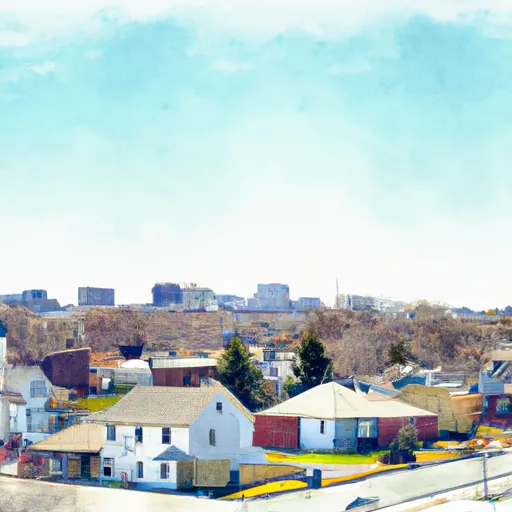-
 Snoflo Premium
Snoflo Premium
Get unlimited access to all our content
With no Ad interruptions! - Start Your Free Trial Login with existing account
Levittown
Eden Index
Climate
9.6
•
Recreation
2.8
•
Community
4.1
•
Safeguard
5.9/10

Levittown, Pennsylvania is a suburban community located in Bucks County, approximately 25 miles northeast of Philadelphia. The climate in Levittown is characterized by hot summers and cold winters, typical of the mid-Atlantic region. Summers are humid, with temperatures ranging from the mid-70s to low 90s Fahrenheit, while winters average in the mid-30s to low 40s Fahrenheit. Precipitation is fairly evenly distributed throughout the year, with an average of 42 inches annually.
The hydrology constituents in Levittown include several water bodies, such as the Delaware River and Neshaminy Creek, providing opportunities for water-based outdoor recreation. Fishing, boating, and kayaking are popular activities in these waterways, offering enthusiasts a chance to explore and enjoy the natural beauty of the area.
In addition to water-related activities, Levittown offers various outdoor recreation opportunities. There are numerous parks, trails, and green spaces in the area, providing residents and visitors with options for hiking, picnicking, and sports activities. Local parks, such as Falls Township Community Park and Middletown Community Park, feature playgrounds, athletic fields, and walking paths, making them ideal for families and individuals looking to spend time outdoors.
Overall, Levittown, Pennsylvania offers a diverse range of outdoor recreation opportunities, complemented by a climate that allows for year-round enjoyment of these activities.
What is the Eden Index?
The Snoflo Eden Index serves as a comprehensive rating system for regions, evaluating their desirability through a holistic assessment of climate health, outdoor recreation opportunities, and natural disaster risk, acknowledging the profound impact of these factors on livability and well-being.
Climate Health Indicator (CHI): 9.6
Levittown receives approximately
1209mm of rain per year,
with humidity levels near 76%
and air temperatures averaging around
13°C.
Levittown has a plant hardyness factor of
7, meaning
plants and agriculture in this region tend to thrive during the non-winter months.
By considering the ideal temperature range, reliable water supplies, clean air, and stable seasonal rain or snowpacks, the Climate Health Indicator (CHI) underscores the significance of a healthy climate as the foundation for quality living.
A healthy climate is paramount for ensuring a high quality of life and livability in a region, fostering both physical well-being and environmental harmony. This can be characterized by ideal temperatures, reliable access to water supplies, clean air, and consistent seasonal rain or snowpacks.
Weather Forecast
Streamflow Conditions
Lower Delaware
Area Rivers
Lower Delaware
Snowpack Depths
Lower Delaware
Reservoir Storage Capacity
Lower Delaware
Groundwater Levels
Recreational Opportunity Index (ROI): 2.8
The Recreational Opportunity Index (ROI) recognizes the value of outdoor recreational options, such as parks, hiking trails, camping sites, and fishing spots, while acknowledging that climate plays a pivotal role in ensuring the comfort and consistency of these experiences.
Access to outdoor recreational opportunities, encompassing activities such as parks, hiking, camping, and fishing, is crucial for overall well-being, and the climate plays a pivotal role in enabling and enhancing these experiences, ensuring that individuals can engage in nature-based activities comfortably and consistently.
Camping Areas
| Campground | Campsites | Reservations | Toilets | Showers | Elevation |
|---|---|---|---|---|---|
| Voorhees State Park | 45 | 752 ft | |||
| Spruce Run Recreation Area | 65 | 309 ft | |||
| Atsion - Wharton State Forest | 50 | 51 ft | |||
| Bulls Island State Park | 70 | 98 ft | |||
| Willow Pond Camp Military - Ft Dix | None | 136 ft |
Nearby Ski Areas
Catastrophe Safeguard Index (CSI):
The Catastrophe Safeguard Index (CSI) recognizes that natural disaster risk, encompassing floods, fires, hurricanes, and tornadoes, can drastically affect safety and the overall appeal of an area.
The level of natural disaster risk in a region significantly affects safety and the overall livability, with climate change amplifying these risks by potentially increasing the frequency and intensity of events like floods, fires, hurricanes, and tornadoes, thereby posing substantial challenges to community resilience and well-being.
Community Resilience Indicator (CRI): 4.1
The Community Resilience Indicator (CRI) recognizes that education, healthcare, and socioeconomics are crucial to the well-being of a region. The CRI acknowledges the profound impact of these elements on residents' overall quality of life. By evaluating educational resources, healthcare accessibility, and economic inclusivity, the index captures the essential aspects that contribute to a thriving community, fostering resident satisfaction, equity, and social cohesion.

